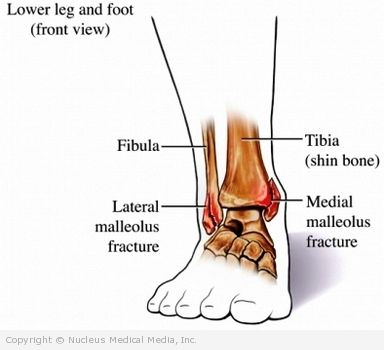Ankle fracture
(Broken Ankle)
Ankle fracture – Definition
An ankle fracture is a break in the ankle joint. The joint is made up of three bones:
- Tibia (shin bone) — the main bone of the lower leg that runs along the inside of the leg
- Fibula — the smaller bone of the lower leg that runs along the outside of the leg
- Talus — the bone that provides the connection between the leg and the foot and is less often fractured than the others
The ankle joint is supported by three groups of ligaments. An injury that causes a fracture may also damage one or more of these ligaments.
Ankle fracture – Causes
An ankle fracture can occur when the joint is forced beyond its normal range of motion or when there is a direct blow to the bone itself. Any form of ankle trauma may cause injury, including:
- Falls
- Twists
- Blows
- Collisions
Ankle fracture – Risk Factors
A risk factor is something that increases your chance of getting a disease, condition, or injury. Risk factors include:
- Decreased muscle mass
- Osteoporosis (common in women after menopause and in older, less active people)
- Any condition that increases the risk of falls such as poor muscle control or poor balance
- Participation in certain sports, such as basketball, football, soccer, and skiing
- Being overweight can increase the risk of fractures and make rehabilitation more difficult
Ankle fracture – Symptoms
Symptoms include:
- Immediate pain (can be severe, but sometimes with fibula injuries, is surprisingly minor)
- Swelling
- Bruising around the injured area
- Tenderness when touching the injured bone in the ankle area
- Inability to put weight on the injured foot without pain, although with minor fractures some people will be able to walk
Ankle fracture – Diagnosis
The doctor will ask about your symptoms, physical activity, and how the injury occurred. An examination of the injured area will be done.
Tests may include x-rays. They use radiation to take a picture of structures inside the body, especially bones.
Ankle fracture – Treatment
Treatment will depend on the severity of the injury. Treatment includes:
- Putting the pieces of the bone back into position, which may require anesthesia and/or surgery
- Holding the pieces together while the bone heals itself
Devices that may be used to hold the bone in place while it heals include:
- A cast (may be used with or without surgery)
- A metal plate with screws (requires surgery)
- Screws alone (requires surgery)
- A rod down the middle of the bone (requires surgery)
The doctor may prescribe pain medication. Your doctor will order more x-rays while the bone heals to ensure that the bones have not shifted position.
Ankle fracture – Exercises
When your doctor decides you are ready, start range-of-motion and strengthening exercises. You may be referred to a physical therapist to help you with these exercises. Do not return to sports activity until the doctor says your ankle is fully healed and you have near normal motion and muscle strength.
Ankle fracture – Healing Time
It takes at least 6-8 weeks for even a simple ankle fracture to heal. It will be several months before you can return to intense physical activity.
Ankle fracture – Prevention
To help prevent ankle fractures:
- Do not put yourself at risk for trauma to the ankle.
- Eat a diet rich in calcium and vitamin D.
- Do weight-bearing exercises to build strong bones.
- Build strong muscles to prevent falls and to stay active and agile.

